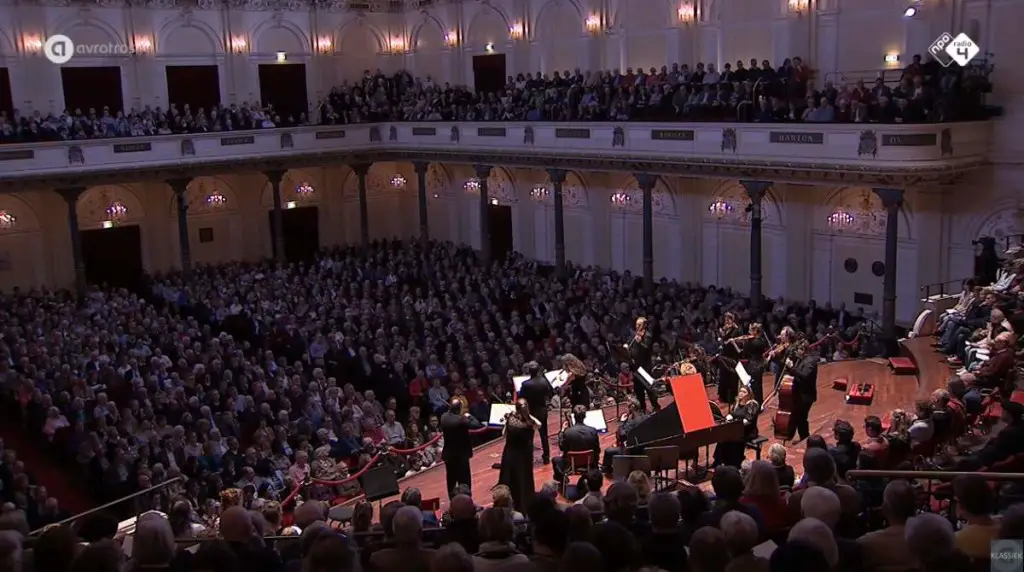California-based early music ensemble Voices of Music performs Johann Sebastian Bach’s Brandenburg Concerto No. 4 with original instruments. Recorded at St. Stephen’s Episcopal Church, Belvedere, California.
Please consider a donation, and support this wonderful ensemble.
Voices of Music: The musicians and their instruments
- Carla Moore, solo baroque violin by Johann Georg Thir, Vienna, 1754
- Hanneke van Proosdij and Andrew Levy, recorders.
- Recorder by Peter van der Poel, based on instruments by Thomas Stanesby Jr, London
- Echo flutes by Peter van der Poel and Von Huene workshop; design & research by Hanneke van Proosdij, David Tayler, and Thomas Winter
- Kati Kyme, baroque violin by Johann Gottlob Pfretzschner, Mittenwald, 1791
- Gabrielle Wunsch, baroque violin by Lorenzo Carcassi, Florence, Italy, 1765
- Lisa Grodin, baroque viola by Mathias Eberl, Salzburg, Austria, 1680
- William Skeen, five-string baroque cello, Anonymous, Italy, c1680
- Farley Pearce, violone, George Stoppani, Manchester, 1985, after Amati, 1560
- Katherine Heater, double-manual harpsichord by Johannes Klinkhamer, Amsterdam (1996), after Ruckers-Goujon, Neuchâtel, Switzerland, 18th c.
Bach’s Brandenburg Concerto No. 4
The six Brandenburg concertos represent the summa of chamber music in the high baroque period: for the fourth concerto (BWV 1049), Bach chose the unique and imaginative texture of baroque violin and “echo flutes” (a type of baroque recorder) for his soloists.
In his autograph manuscript of Brandenburg 4 (BWV 1049), Bach writes the title as follows:
“Concerto 4to à Violino Principale, due Fiauti d’Echo, due Violini, una Viola è Violone in Ripieno, Violoncello è Continuo.” For the video, the ensemble uses the “echo flutes” for the slow movement, then breaks them apart for the first and third movements. The outside movements feature exceptionally virtuosic writing for the violin, with extended passagework spanning the entire range of the instrument. For his fourth concerto in the set of Brandenburgs, Bach is especially careful with the orchestration: this creates space for the recorder sound to breathe; in addition, his compositional style flows with sparkle and wit.
Brandenburg Concerto No. 4 concerto is unusual in that Bach specifically calls for “echo flutes”, or “fiauti d’echo”. For many years musicologists have debated what an “echo flute” exactly is, and have also uncovered a great deal of historical detail, but the work is usually performed with two alto recorders.
Our reconstruction of Bach’s echo flutes for this performance and video recording is based on a number of key historical facts. First, the diarist Samuel Pepys details on several occasions his visits to the shop of Drumbleby, who sold wind instruments. Here is the excerpt from January, 1668:
“20th. Up, and all the morning at the office very busy, and at noon by coach to Westminster, to the ‘Chequer, about a warrant for Tangier money. In my way both coming and going I did stop at
Drumbleby’s, the pipe-maker, there to advise about the making of a flageolet to go low and soft; and he do shew me a way which to do, and also a fashion of having two pipes of the same note fastened together, so as I can play on one, and then echo it upon the other, which is mighty pretty.”Other historical accounts refer to a number of virtuoso players of the echo flute in different countries, and describe the instrument as two recorders or similar wind instruments, one of which is voiced softer than the other. Surviving echo flutes, consisting of a pair of recorders joined together, show that instrument makers of the time were keenly aware of how to voice the two instruments to create differences in sound.
The baroque echo flute solves a fundamental problem with the recorder and other wind instruments which is that as the player blows softer, the pitch goes lower. Since both echo and dynamic effects were essential to baroque music, the echo flute is a recorder that can play dynamics—and play them well in tune.
For our recording, we have chosen recorders that have a difference in color and articulation as well as in the volume of sound. We believe that Bach, who played the double-manual harpsichord as well the organ, would have been drawn to an instrument that could realize a rich palette of colors for the performance of his work, just as the harpsichord, which has two complete sets of strings, provides contrasts in color and articulation as well as in dynamics.
This concerto is part of the Voices of Music Great Works project. A Creative Commons edition of the score, based on the composer’s manuscript, will be published to accompany the complete recording, and the recording will be available worldwide on Blu-Ray and CD, and for free on MP3 and highdefinition, 24 bit FLAC files. First published October 22, 2013.
Voices of Music, Hanneke van Proosdij & David Tayler, directors
Sources
- Voices of Music’s official website voicesofmusic.org
